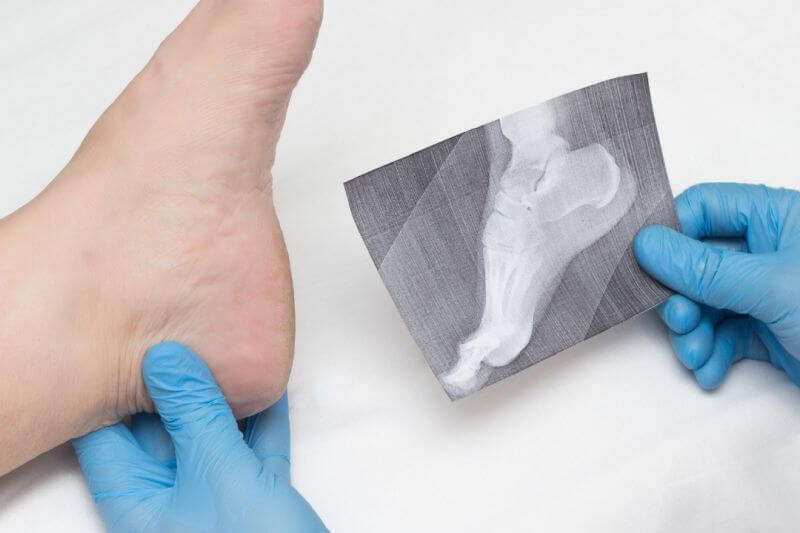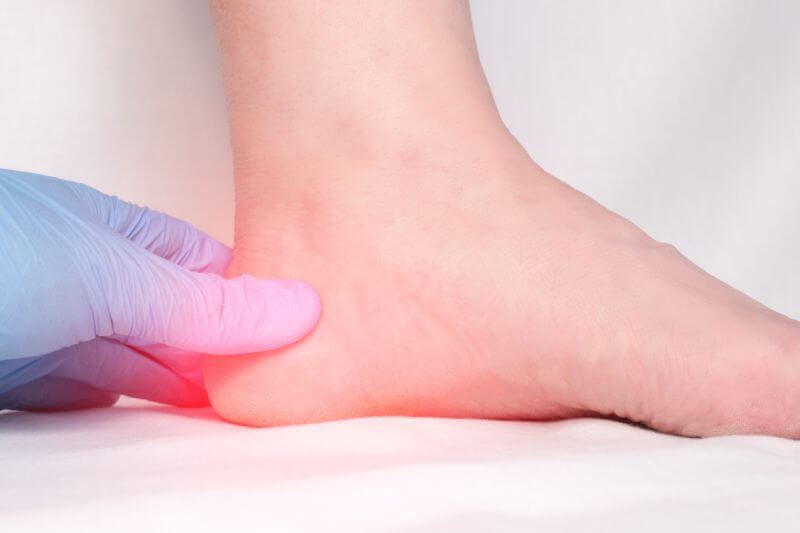Heel spur (calcar calcanei) belongs to tendon pain (enthesopathy). Heel spur, its causes, symptoms and treatment are further discussed by physiotherapist Sona Barvencikova from Fyzionozka.
Content of the article
Heel spur causes
Heel spur is caused by overloading of the calf muscle (m. triceps surae), Achilles tendon, plantar aponeurosis, ligaments and bursae on the plantar surface. It is a bony growth that burrows into the soft tissues in the heel area. It is characterized by pain on first morning step or pain on sharp stepping. It is important to remember that heel spurs do not occur overnight, they develop through prolonged overuse, unilateral weight bearing and microtrauma.
All this then leads to the development of functional and morphological changes. These changes impair the comfort of movement and can lead to a disruption of the integrity of the organism. If the tendon attachment area is affected and inflammatory changes develop, it is considered an enthesopathy. The tendons are relatively poorly supplied with blood vessels and the working muscles also draw part of their vascular supply on themselves. This means that uneconomical work of the muscle (overworking) further aggravates the problem. Thus, uneconomical muscle work leads to disability in the area of the tendon attachments, tendon sheaths and joint capsules.

Heel spur symptoms
Initially, tendon pains occur after weight-bearing. The typical symptom is morning pain (when first stepping on the foot) and pain after sharp stepping. Gradually, the pain worsens with movement and load, accompanying each step, until resting pain may occur. The affected area may appear weakened, and painful spots (tightened muscle fibres, called trigger points) may develop in the muscles. The area may be swollen, red and warm to the touch. If we do not perceive the body's signals and do not address the problem, calcifications, loosening of the tendon, etc. can occur.
As a consequence of the above, soft tissue involvement, blockages in the small joints of the leg, shortened calf muscle, pain points (trigger points) in the calf muscle, shortened plantar aponeurosis, blockages in the ankle joint are found on examination of the area.
Risk factors
Risk factors for heel spurs include prolonged static weight-bearing, inappropriate footwear, frequent walking on hard ground, obesity and flat feet. We also often find non-ideal heel positioning, which leads to uneconomical force transfer when muscles are pulled during movement. If the foot arch is not functioning properly, the foot is loaded mainly in the heel area as the load is not distributed over the arch rays.
Heel spur treatment
The primary goal of treatment is to address the cause with elements of physiotherapy. Active exercises aimed at correcting the gait stereotype, training the correct stride and unwinding of the foot are used. Proper alignment of the entire lower limb is practiced and the postural muscles are activated. In addition to the above, we also use various balance aids, exercises with a ball or an overball. Mobilization techniques, soft tissue relaxation and foot massage are applied. To relieve the area, kinesiotaping can be used as an effective method.

The supporting treatment is a physical therapy. The selection of the right footwear is important, or the choice of an individually corrected insole that will help to bring the heel into the correct position. Gel aids should be chosen and used with care, as they often deflect the heel from its ideal position by moving over the gel. When the opportunity arises, leave your feet free and walk barefoot in the countryside. Toe spacers can also be used to loosen the feet. As a last resort, surgical treatment may be necessary.
Physical therapy
Physical therapy is the use of several forms of physical energy to treat and prevent various disorders, mainly of the musculoskeletal system. Therapeutic ultrasound, magnetotherapy, laser and shock wave are mainly used in the treatment of heel spurs.
- Ultrasound – is a form of mechanical energy and has significant analgesic (pain reducing) effects when applied correctly. It uses the effect of micro-massage, which leads to a significant blood supply to the tissues with a consequent increase in oxygenation, nutrient supply and flushing of unwanted harmful metabolites.
- Magnetotherapy – has an anti-inflammatory and analgesic effect. The application starts the regenerative mechanisms in the affected area in order to prevent further formation of bone spurs.
- Laser – has a biostimulating effect, accelerates regenerative processes. It also has an analgesic and anti-inflammatory effect. It increases blood circulation in the treated area. Laser therapy is a very effective method without side effects.
- Shock wave – is a powerful and at the same time non-invasive treatment method in the treatment of heel spurs. Studies conducted show a positive effect of shock wave application in more than 60% of patients. The best results are described with repeated application (3 to 6 treatments) in combination with exercise. The resulting calcifications are disrupted and absorbed by the vascular and lymphatic systems. After application, there is increased blood flow to the treated area, which accelerates healing. The action of the shock wave further reduces pain.
However, each of us is an individual and may have different experiences with the effect of complementary therapies.

Heel spur surgery
The surgical procedure removes the heel spur and part of the ligamentous structures around the heel bone. The surgery can be performed arthroscopically, the procedure is less invasive than the original large surgical incision. After the surgery, walking with crutches for 6 weeks and subsequent weight-bearing is required. Full weight-bearing is possible after 3 months at the earliest.
Which shoes for heel spur?
As we described above, the heel spur needs a soft step. For a short walk in the countryside or garden, go barefoot or in barefoot shoes. Stimulating the foot by walking is good, it acts similar to a massage.
However, for the city, for the office, for a long hike, or simply when steping on hard surfaces, you should choose a shoe with a higher sole that cushions the impact. Of course, look for shoes that are roomy and anatomically shaped in the toe, so that by squeezing the toes (and thus deforming the foot) you don't put pressure on the musculoskeletal system, which would shift health complications elsewhere. However, avoid ultra-thin soles.
If you can't find a suitable compromise shoe, the solution is to insert a thicker insole into barefoot shoes, where you maintain the ideal proportions of the shoe and the insole adds cushioning to the shoe. We recommend that you consult a physiotherapist about the suitability of the shoes/inserts, or they will make bespoke insoles for you.
